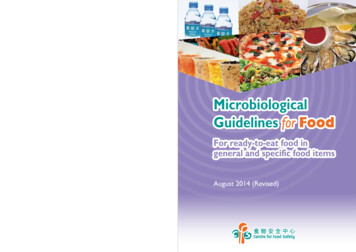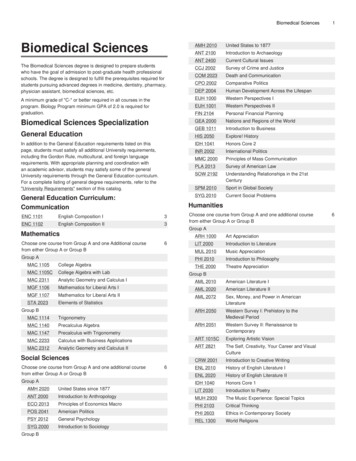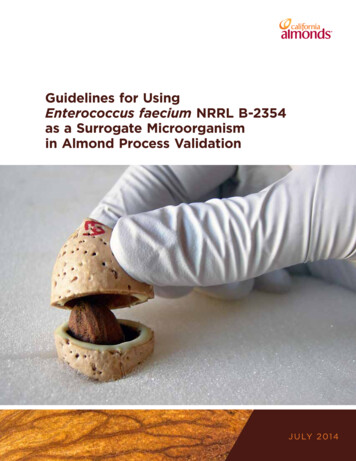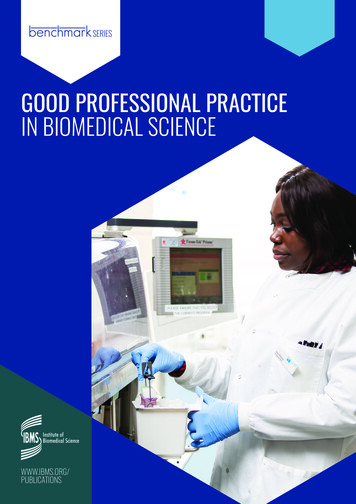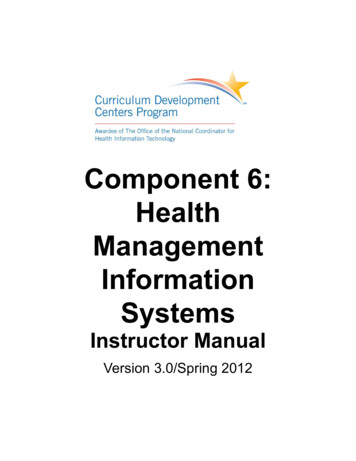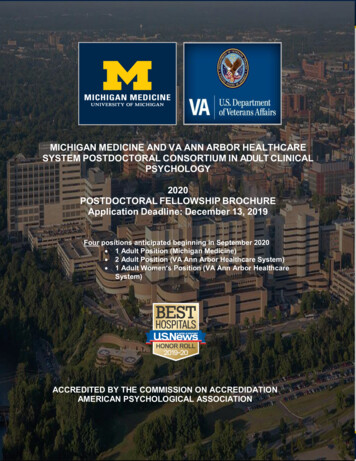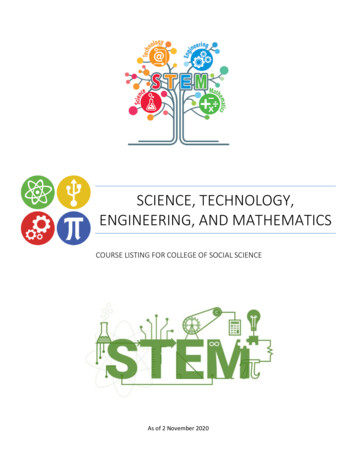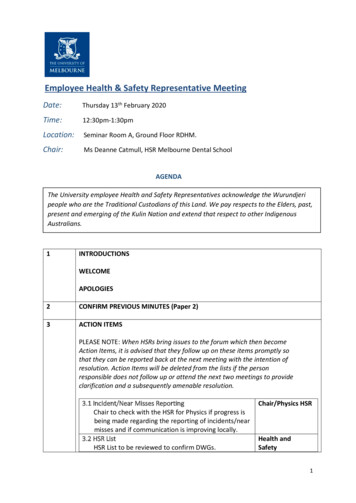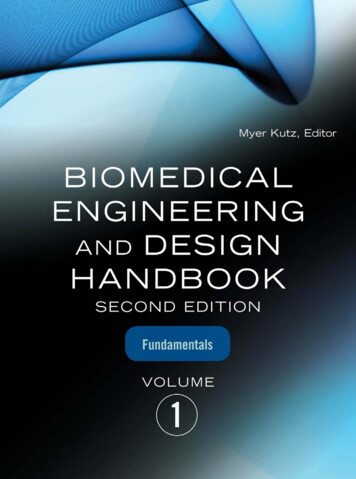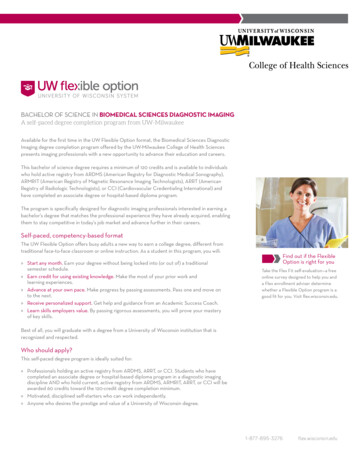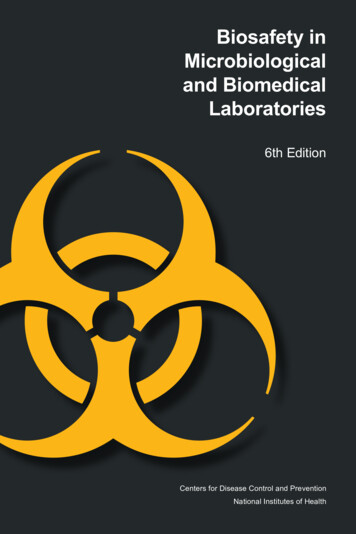
Transcription
Biosafety inMicrobiologicaland BiomedicalLaboratories6th EditionCenters for Disease Control and PreventionNational Institutes of Health
Inside front cover
Biosafety inMicrobiologicaland BiomedicalLaboratories6th EditionU.S. Department of Health and Human ServicesPublic Health ServiceCenters for Disease Control and PreventionNational Institutes of HealthRevised June 2020
ForewordBiosafety in Microbiological and Biomedical Laboratories (BMBL) has servedas the cornerstone of biosafety practice in the United States since its initialrelease. We wish to emphasize that the sixth edition of BMBL remains anadvisory document recommending best practices for the safe conduct of workin biomedical and clinical laboratories from a biosafety perspective. The BMBLis not intended to be a regulatory document although we recognize that somemay use it in that way. The core principle of this document is protocol-driven riskassessment; it is not possible for a single document to identify all of the possiblecombinations of risks and mitigations feasible in biomedical and clinical laboratories. The BMBL should be used as a tool in the assessment and proposedmitigation steps in biomedical and clinical laboratories.This edition of BMBL includes revised sections, agent summary statements,and appendices. We harmonized the recommendations included in this editionwith guidance issued and regulations promulgated by other organizations andfederal agencies. Wherever possible, we clarified both the language and intentof the information provided. In order to serve the needs of our community better,this edition includes new appendices on the following topics: inactivation andverification; laboratory sustainability; large-scale biosafety; and clinical laboratorybiosafety.Over 200 of our scientific and professional colleagues contributed to the preparation of the sixth edition through participation in technical working groups andserving as reviewers, guest editors, and subject matter experts. We wish to thankthem all for their dedication and hard work. Without them, the sixth edition ofBMBL would not be possible. We also recognize the hard work and contributionsmade by all who participated in preparation of the previous editions of BMBL; wehave built on their solid work and commitment.It would have been impossible to publish this revision without recognizing thevisionary leadership of the previous BMBL editors—Drs. John Richardson,W. Emmett Barkley, Jonathan Richmond, Robert W. McKinney, Casey Chosewood,and Deborah Wilson—without whom the BMBL would not be the respectedresource it is today. The Steering Committee members, Drs. Christy Myrick,Richard G. Baumann, Margy Lambert, Patricia Delarosa, and Theresa Lawrence,were instrumental in identifying authors, selecting additions to this edition, andreviewing submissions. Their significant contribution to this edition is sincerelyappreciated.We are truly grateful to Ms. Shaina Mangino and Dr. Mallory Pomales of EagleMedical Services, LLC for their expertise and patience in assisting us with thisundertaking. Their superb organizational and editing skills were critical in thecreation of this document.Forewordiii
We hope you find the sixth edition of Biosafety in Microbiological and BiomedicalLaboratories complete, timely, and most of all, easy to use. Thank you for yourpatience and understanding during the long and comprehensive revision process.Paul J. Meechan, PhD, MPH, RBP, CBSP(ABSA)Associate Director for Laboratory SafetyOffice of Laboratory Science and SafetyCenters for Disease Control and PreventionAtlanta, GAJeffrey Potts, MPH, CBSP(ABSA)Chief, Biorisk Management BranchDivision of Occupational Health and SafetyNational Institutes of HealthBethesda, MDivBiosafety in Microbiological and Biomedical Laboratories
ParticipantsSenior Co-EditorsPaul J. Meechan, PhD, MPH, RBP, CBSP(ABSA)Associate Director for Laboratory SafetyOffice of Laboratory Science and SafetyCenters for Disease Control and PreventionJeffrey Potts, MPH, CBSP(ABSA)Chief, Biorisk Management BranchDivision of Occupational Health and SafetyNational Institutes of HealthSteering CommitteeRichard G. Baumann, PhD, SM(NRCM)Biological Safety OfficerDivision of Occupational Health and SafetyNational Institutes of HealthPatricia Delarosa, PhD, CBSP(ABSA), CTM(ATAP)Health Scientist, BiosafetyOffice of Strategy, Policy, Planning, and RequirementsOffice of the Assistant Secretary for Preparedness and ResponseDepartment of Health and Human ServicesMargy Lambert, PhDHealth ScientistOffice of Science and Technology AssessmentOccupational Safety and Health AdministrationCAPT Theresa Lawrence, PhDSenior Science OfficerOffice of the Associate Director for Preparedness and ResponseU.S. Department of Health and Human ServicesPaul J. Meechan, PhD, MPH, RBP, CBSP(ABSA)Associate Director for Laboratory SafetyOffice of Laboratory Science and SafetyCenters for Disease Control and PreventionForewordv
Christy Myrick, PhD, RBP(ABSA)Lead AuditorU.S. National Authority for Containment for PoliovirusesCenter for Preparedness and ResponseCenters for Disease Control and PreventionJeffrey Potts, MPH, CBSP(ABSA)Chief, Biorisk Management BranchDivision of Occupational Health and SafetyNational Institutes of HealthDeborah E. Wilson, DrPH, CBSP(ABSA)RADM (ret.), U.S. Public Health Service,Division of Occupational Health and Safety—DirectorOffice of Research ServicesNational Institutes of HealthTechnical EditorsShaina ManginoSenior Publications EditorEagle Medical Services, LLCMallory J. Pomales, DOSenior Program Manager for Scientific WritersSenior Scientific EditorEagle Medical Services, LLCPrimary AuthorsMatthew J. Arduino, MS, DrPH, FSHEA, M(ASCP)CMSr. Adviser, Environmental Hygiene and Infection PreventionOffice of the DirectorDivision of Healthcare Quality PromotionCenters for Disease Control and PreventionWilliam D. ArndtHealth Scientist—BioriskDivision of Laboratory SystemsCenters for Disease Control and PreventionHeike Bailin, MDStaff Physician, Occupational Medical ServiceDivision of Occupational Health and SafetyNational Institutes of HealthviBiosafety in Microbiological and Biomedical Laboratories
Richard G. Baumann, PhD, SM(NRCM)Biological Safety OfficerDivision of Occupational Health and SafetyNational Institutes of HealthRichard S. Bradbury, PhD, FFSc RCPADivision of Parasitic Diseases and MalariaCenter for Global HealthCenters for Disease Control and PreventionMary E. Brandt, PhDOffice of Laboratory Science and SafetyCenters for Disease Control and PreventionCristina Bressler, MBAHealth ScientistOccupational Health and Safety OfficeOffice of Safety, Security and Asset ManagementCenters for Disease Control and PreventionByron Caughey, PhDSenior InvestigatorLaboratory of Persistent Viral Diseases, Rocky Mountain LaboratoriesNational Institute for Allergy and Infectious DiseasesNational Institutes of HealthRear Admiral Terri R. Clark, DVM, DACLAMDirector (ret.), Office of Animal Care and UseAssistant Surgeon GeneralUSPHS Commission CorpsNational Institutes of HealthDanielle Daniely, PhD, RBP(ABSA)Director, Research Safety Programs and High Containment LaboratoriesOffice of Research IntegrityGeorgia State UniversityPatricia Delarosa, PhD, CBSP(ABSA), CTM(ATAP)Health Scientist, BiosafetyOffice of Strategy, Policy, Planning, and RequirementsOffice of the Assistant Secretary for Preparedness and ResponseDepartment of Health and Human ServicesForewordvii
Stephen Denny, DVM, MS, DACLAM, DACVPMActing Director, Office of Animal Care and UseOffice of Intramural ResearchNational Institutes of HealthEileen EdmonsonTransportation Regulations SpecialistStandards and Rulemaking DivisionPipeline and Hazardous Materials Safety AdministrationU.S. Department of TransportationSamuel S. Edwin, PhDDirectorDivision of Select Agents and ToxinsCenter for Preparedness and ResponseCenters for Disease Control and PreventionElizabeth (Zeba) Floyd, AIA, LEED AP BD C ID CProject DirectorSustainable Design Consulting, LLCKaren M. Frank, MD, PhD, D(ABMM)Chief, Department of Laboratory MedicineClinical CenterNational Institutes of HealthMark D. Gibson, MS, CIHSenior Industrial HygienistDivision of Occupational Health and SafetyNational Institutes of HealthEduardo Gomez-Saladin, PhD, SM, RBP, CBSP(ABSA)Deputy DirectorOffice of Laboratory SafetyCenters for Disease Control and PreventionNatasha K. Griffith, MSChief, Quality and Safety Systems BranchDivision of Laboratory SystemsCenters for Disease Control and PreventionviiiBiosafety in Microbiological and Biomedical Laboratories
Ted Hackstadt, PhDChief, Host-Parasite Interactions SectionLaboratory of BacteriologyRocky Mountain LaboratoriesNational Institute for Allergy and Infectious DiseasesNational Institutes of HealthSusan B. Harper, DVM, MS, DACLAM, DACVPM, RBP(ABSA)Office of National ProgramsUSDA Agricultural Research ServiceKathryn L. Harris PhD, RBP(ABSA)Senior Outreach and Education SpecialistBiosafety, Biosecurity and Emerging Biotechnology Policy DivisionOffice of Science PolicyNational Institutes of HealthMark L. Hemphill, MSDeputy Director, Division of Select Agents and ToxinsCenter for Preparedness and ResponseCenters for Disease Control and PreventionBarbara L. Herwaldt, MD, MPHMedical Epidemiologist, Division of Parasitic Diseases and MalariaCenters for Disease Control and PreventionNancy P. Hoe, PhD, CBSP(ABSA)Biosafety Officer/Responsible Official for Rocky Mountain LaboratoriesDivision of Occupational Health and SafetyOffice of the Director, National Institutes of HealthJoseph P. Kozlovac, MS, RBP, CBSP(ABSA), SM(NRCM)Agency Biosafety OfficerUSDA Agricultural Research ServiceOffice of National ProgramsMargy Lambert, PhDHealth ScientistOffice of Science and Technology AssessmentOccupational Safety and Health AdministrationGeorge W. LathropVeterinary Medical OfficerNational Center for Emerging and Zoonotic Infectious DiseasesCenters for Disease Control and PreventionForewordix
Susan Lawrence, PhDBranch ChiefMicrobiology BranchEnvironmental Protection AgencySusan A. Lippold, MD, MPHMedical DirectorOccupational Health ClinicCenters for Disease Control and PreventionR. Trevor LubbertBoard Certified Senior Staff EntomologistCommunity Health BranchDivision of Occupational Health and SafetyOffice of Research SafetyNational Institutes of HealthCarolina Lúquez, PhDNational Botulism and Enteric Toxins TeamEnteric Diseases Laboratory BranchDivision of Foodborne, Waterborne, and Environmental DiseasesNational Center for Emerging and Zoonotic Infectious DiseasesCenters for Disease Control and PreventionPatrick M. McNutt, PhDPrincipal InvestigatorDepartment of NeuroscienceU.S. Army Medical Research Institute of Chemical DefensePaul J. Meechan, PhD, MPH, RBP, CBSP(ABSA)Associate Director for Laboratory SafetyOffice of Laboratory Science and SafetyCenters for Disease Control and PreventionBarbara Owen, MPH, CBSP(ABSA), RBP, NRCM, CMMDirector, Global Safety and EnvironmentCorporate Biosafety OfficerMerck & Co., Inc.Steven Piguet, AIA, LEED Fellow, Fitwel AmbassadorAssociate PrincipalSustainable Design Consulting, LLCxBiosafety in Microbiological and Biomedical Laboratories
Segaran P. Pillai, PhD, SM(NRCM), SM(ASCP), FAAMDirector, Office of Laboratory Science and SafetyOffice of the CommissionerFood and Drug AdministrationJeffrey Potts, MPH, CBSP(ABSA)Chief, Biorisk Management BranchDivision of Occupational Health and SafetyNational Institutes of HealthNathaniel Powell Jr., DVM, MSChief, Comparative Medicine BranchDivision of Scientific ResourcesNational Center for Emerging and Zoonotic Infectious DiseasesCenters for Disease Control and PreventionAnn M. Powers, PhDLead, Virology TeamArboviral Diseases BranchDivision of Vector-Borne DiseasesCenters for Disease Control and PreventionReynolds M. Salerno, PhDDirector, Division of Laboratory SystemsCenters for Disease Control and PreventionDr. Martin L. Sanders, PhD, CSPDirector, Safety, Emergency, and Environmental ComplianceDepartment of Health and Human ServicesJames M. Schmitt, MD, MSMedical DirectorOccupational Medical ServiceDivision of Occupational Health and SafetyNational Institutes of HealthStephen Tomasino, PhDSenior ScientistEnvironmental Protection AgencyElizabeth G. Weirich, MS, SM(NRCM), CBSP(ABSA)Division of Laboratory SystemsCenters for Disease Control and PreventionForewordxi
David M. White, DVM, PhD, RBP(ABSA), DACVMSafety & Security Unit LeadNational Centers for Animal HealthUSDA Animal and Plant Health Inspection ServiceDeborah E. Wilson, DrPH, CBSP(ABSA)RADM (ret.), U.S. Public Health Service,Division of Occupational Health and Safety—DirectorOffice of Research ServicesNational Institutes of HealthLiz E. York, FAIAChief Sustainability OfficerOffice of the Chief Operating OfficerCenters for Disease Control and PreventionxiiBiosafety in Microbiological and Biomedical Laboratories
ContributorsMichael AdlerEdward DuboviCrystal JohnsonKaren AndersonEilyn FabregasEric A. JohnsonRebecca V. AndersonChadi FilfiliJulie JohnsonMatthew J. ArduinoBetty A. ForbesEstella Z. JonesDavid AsherMarshall GaytonJoanne Jones-MeehanJohn BalogSarah GenzerGerardo KaplanShawn A. BeanChristopher GoodDavid E. BentzelAndrew HaddowSubhashinieKariyawasamCary R. BinderJaqueline KatzBrad BlitvichVibeke (Vips)Halkjaer-KnudsenArifa KhanKathryn BoardAlexander HambergLydia KibiukWilliam P. BozzaGlen HansenChris KileyMegan Morgan BroseDavid HarbourtManley KiserRobert BullKathryn L. HarrisRajen KoshyCara BurnsCourtney HarrisonLaura KramerSheldon CampbellMichael W. HartPhilip KrauseCynthia CaryRobert HawleyJens KuhnNick ChaplinskiHenry HaysAnna LlewellynMark ChappellJohn HennemanMaria LorenzoKonstantin ChumakovStephen HiggsLuis Lugo-RomanJeffrey CohenJulia HilliardEugene ColeMichael HolbrookNicole LukovskyAkhsanovNancy CornishBill HomovecWhitni DavidsonRomney HumphriesC. Todd DavisDebra HuntSabrina DeboseFreeda IsaacJohnathan R. DeedsEddie L. JacksonThomas DenagamagePeter JahrlingBeverly DicksonRobert JambouGerhard DoblerEric JeppesenMike DrebotBarbara JohnsonMarian MajorMonear MakvandiAlison MawleErin McElvaniaThomas A. McKeonDavid Scott McVeyThomas P. MonathRashida MooreDavid MorensEric C. MosselForewordxiii
Krista MurrayChristy MyrickBrandy NelsonJoseph NewsomeStuart NicholKenneth E. NusbaumSteve OberstePatricia OlingerLillian OrciariEugene O’ReillyLawrence B.SchonbergerDiana WhippleLynne M. SehulsterAxel WolffBrianna SkinnerHalley SmithJames SynderMarisa Elkins St. ClaireJames StevensMolly Stitt-FischerJames R. SwearengenMark PagalaWilliam M. SwitzerSubbian Satheshkumar(Sathesh) PanayampalliSandra TallentCassandra TanseyEun-Chung ParkRobert TeshAmar PatilAnil J. ThachilMichael A. PentellaEileen L. ThackerWilliam PetersNatalie J. ThornburgBrett PetersenWilliam H. TollesonBrian R. PetuchJohn TonkissSusan C. PiguetAlthea C. TreacyEwan PlantAnita TrichelKristin PrenticeJessica TuckerSuzette PriolaTerrence TumpeyAmy PullmanTimothy UyekiRichard RebarFrancisco A. UzalYvonne ReedNikos VasilakisRyan F. RelichLinfa (Lin-Fa) WangPierre RollinDavid WarnockEugene RosenthalScott WeaverScott RuskZachary WeinerJanice RusnakRebecca WeingartenArick P. SabinRobbin WeyantMo D. SalmanMark WharyxivBiosafety in Microbiological and Biomedical LaboratoriesTemeri Wilder-KofieZhiping YeKyoung-Jin YoonEdward YouJessica YoungBaolin Zhang
ContentsForeword. iiiParticipants. vSenior Co-Editors. vSteering Committee. vTechnical Editors.viPrimary Authors.viSection I—Introduction . 1The Occurrence of Laboratory-associated Infections . 1Evolution of National Biosafety Guidelines. 3Risk Criteria for Establishing Ascending Levels of Containment. 4Agent Summary Statements. 5Laboratory Biosecurity. 6Using Biosafety in Microbiological and Biomedical Laboratories. 6Looking Ahead. 7References. 7Section II—Biological Risk Assessment. 9The Risk Management Process. 10Risk Communication. 19Facilitating a Culture of Safety through Risk Assessment . 19Conclusion. 20References. 20Section III—Principles of Biosafety. 24Safety Equipment (Primary Barriers). 24Personal Protective Equipment. 25Facility Design and Construction (Secondary Barriers). 25Facility Practices and Procedures. 26Biosafety Levels. 27Animal Facilities. 30Clinical Laboratories. 30Laboratory Biosecurity. 31References. 31Section IV—Laboratory Biosafety Level Criteria. 32Biosafety Level 1. 32A.Standard Microbiological Practices. 32B.Special Practices. 36Contentsxv
C.Safety Equipment (Primary Barriers and PersonalProtective Equipment) . 36D.Laboratory Facilities (Secondary Barriers). 36Biosafety Level 2. 37A.Standard Microbiological Practices. 37B.Special Practices. 40C.Safety Equipment (Primary Barriers and PersonalProtective Equipment). 41D.Laboratory Facilities (Secondary Barriers). 42Biosafety Level 3. 43A.Standard Microbiological Practices. 43B.Special Practices. 46C.Safety Equipment (Primary Barriers and PersonalProtective Equipment). 48D.Laboratory Facilities (Secondary Barriers). 48Biosafety Level 4. 51A.Standard Microbiological Practices. 52B.Special Practices. 55C.Safety Equipment (Primary Barriers and PersonalProtective Equipment). 57D.Laboratory Facilities (Secondary Barriers). 59Section V—Vertebrate Animal Biosafety Level Criteria forVivarium Research Facilities. 70Animal Biosafety Level 1. 71A.Standard Microbiological Practices. 72B.Special Practices. 76C.Safety Equipment (Primary Barriers and PersonalProtective Equipment) . 76D.Animal Facilities (Secondary Barriers). 76Animal Biosafety Level 2. 78A.Standard Microbiological Practices. 78B.Special Practices. 82C.Safety Equipment (Primary Barriers and PersonalProtective Equipment). 83D.Animal Facilities (Secondary Barriers). 84Animal Biosafety Level 3. 87xviA.Standard Microbiological Practices. 87B.Special Practices. 91Biosafety in Microbiological and Biomedical Laboratories
C.Safety Equipment (Primary Barriers and PersonalProtective Equipment). 93D.Animal Facilities (Secondary Barriers). 94Animal Biosafety Level 4. 98A.Standard Microbiological Practices. 98B.Special Practices. 102C.Safety Equipment (Primary Barriers and PersonalProtective Equipment). 104D. Animal Facilities (Secondary Barriers). 108References. 117Section VI—Principles of Laboratory Biosecurity. 119Biosafety and Laboratory Biosecurity. 120Developing a Laboratory Biosecurity Program. 122Example Guidance: A Laboratory Biosecurity Risk Assessmentand Management Process. 123Elements of a Laboratory Biosecurity Program. 124References. 128Section VII—Occupational Health Support for Biomedical Research. 130Framework for Occupational Health Support of BiomedicalResearch . 130Elements of an Occupational Health Program SupportingBiomedical Research. 133Conclusion. 141References. 141Section VIII—Agent Summary Statements. 147References. 147Section VIII-A: Bacterial Agents. 148Bacillus anthracis. 148Bordetella pertussis. 150Brucella species. 152Burkholderia mallei. 154Burkholderia pseudomallei. 156Campylobacter species. 157Chlamydia psittaci, C. trachomatis, C. pneumoniae. 158Clostridium botulinum and neurotoxin-producing speciesof Clostridia. 161Clostridioides (formerly Clostridium) difficile. 162Contentsxvii
Clostridium tetani and Tetanus toxin. 163Corynebacterium diphtheriae. 164Francisella tularensis. 165Helicobacter species. 167Legionella pneumophila and other Legionella spp. 168Leptospira. 169Listeria monocytogenes. 171Mycobacterium leprae. 172Mycobacterium tuberculosis complex. 173Mycobacterium spp. other than M. tuberculosis complexand M. leprae. 175Neisseria gonorrhoeae. 177Neisseria meningitidis. 178Salmonella serotypes, other than S. enterica serotypeTyphi (S. Typhi). 179Salmonella enterica serotype Typhi (S. Typhi). 181Shiga toxin (Verocytotoxin)-producing Escherichia coli. 182Shigella. 184Staphylococcus aureus (Methicillin-Resistant, VancomycinResistant, or Vancomycin-Intermediate). 185Treponema pallidum. 187Vibrio species . 188Yersinia pestis. 189References. 191Section VIII-B: Fungal Agents. 212Blastomyces dermatitidis and Blastomyces gilchristii. 212Coccidioides immitis and Coccidioides posadasii. 213Histoplasma capsulatum. 215Sporothrix schenckii species complex. 216Miscellaneous Yeast and mold organisms causing human infection. 217References. 219Section VIII-C: Parasitic Agents. 223General Issues. 223Blood and Tissue Protozoal Parasites. 223Intestinal Protozoal Parasites. 228xviiiBiosafety in Microbiological and Biomedical Laboratories
Cestode Parasites. 230Trematode Parasites. 232Nematode Parasites. 233References. 237Section VIII-D: Rickettsial Agents. 239Coxiella burnetii. 239Rickettsia species and Orientia tsutsugamushi.
iv Biosafety in Microbiological and Biomedical Laboratories We hope you find the sixth edition of Biosafety in Microbiological and Biomedical Laboratories complete, timely, and most of all, easy to use. Thank you for your patience and understa
